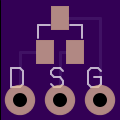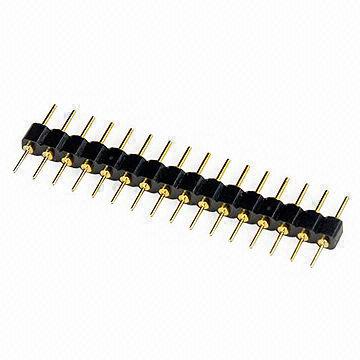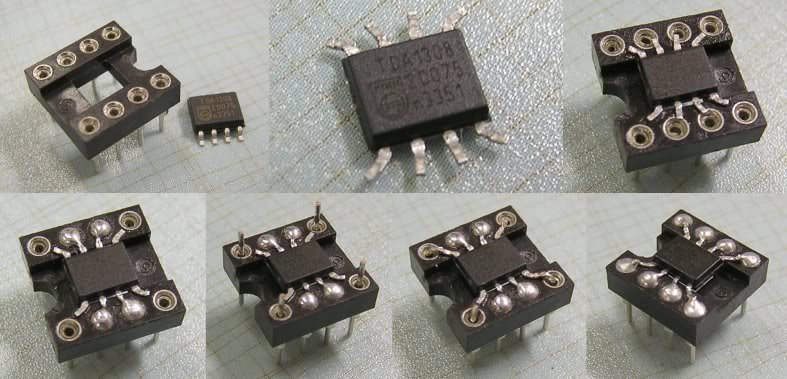Older components? Necessary or swappable
123








123
Older components? Necessary or swappable
|
What parts are necessary, and which can be swapped?
This is a long and complicated topic since the answer varies according to part. It might be nice to have a place where people log suitable substitute part numbers. Also - a place to mention which older parts really should be obtained even at the higher cost. Many layouts here call for parts that are clearly marked obsolete in the product sheets. Although it still may be possible to find them. If you are like me and just started up 6 months ago, you are not stocked up with parts from 10 years ago. And so, in all cases the first thing I do with any parts list is to see if I have the right parts or a suitable substitute - and in most cases I do (since while parts may become obsolete, their functions rarely do). So, when a layout calls for an older part - for example the 2N5484 transistor, many people will ask if J201 is suitable. It seems to be, but it may react a little differently. However, it is still possible to find older parts (such as the 2n5484), at a higher price plus the hassle of waiting and cost of shipping. So - the topic here is this - what older parts are indispensable, and which can be easily substituted? And this could be a good place to keep track of suitable substitutes, since the question is asked so often in comments of various layouts, but it gets overlooked. To get started - what are some of the older parts people here feel are indispensable and should be acquired? Also- which older parts have you started substituting regularly, and what are you using to replace it? Also - which parts would you recommend to new people for stocking up? An example is the newer, smaller capacitors, such as the radial film 1uf. I am seeing these more & more as I see more layouts. |
2n5457 transistor 5817 Schottky diode
|
Two I will ask about which are becoming expensive & more rare...
2n5457 transistors - listed as "available" but out of stock at Tayda. This is called for in many layouts. Is it best to try to get the exact part - or if not, what is best substitute? 5817 Schottky Diode - seemingly replaced by 5818 - is this a reliable substitute? |
|
In reply to this post by motterpaul
This is an interesting topic, as we all love to build a variety of projects but sometimes are stymied by not having several components the circuit needs or any available substitutes. If that happens I'll add the parts I need to the next Mammoth or Small Bear order and put the project on hold. Most online vendors carry a range of parts, including the harder to find transistors and diodes, but they'll be priced accordingly.
Now, if you're interested in what specific parts you should stock up on, here's something that I did which you may find helpful. You can do this in a spreadsheet or on a sheet of paper. Write down all of the projects you think you'll want to build, and even include one which are mildly interesting. For each project, go through the layouts here and tally all of the caps, diodes, pots, transistors/fets, ICs (and perhaps special components like LDRs) that you'll need for each circuit. (Note I didn't include resistors, assuming you're well stocked on those). If you do this on a spreadsheet you can see some trends emerge in the preferred/most used components. For example, I go through a lot of 10 nF, 100 nF, 10 uF, and 100 uF caps. Most projects seem to use one or more of these. I also use a lot of A100K and B50K pots. Likewise for fets, its j201s or 5457s. ICs - TL072s, LF353, JRC 4558, etc. When you buy parts, get a couple more than what you need. You never know if a chip may go bad for example. One reason I like this hobby is that project can be built using about $10 in parts (with the exception of mojo-germanium unobtainium transistors  ). ).
As for substitutes for transistors and ICs, Google is your friend. Just type in <name of part> substitute in the search and see what comes up. Or post the question here. A little research can bring up a plethora of resources. Finally, I know I get the "picker's syndrome" when it comes to stocking up on hard to find (mojo) parts. Wow - NOS germanium transistors - 5 for $10! Well, sometimes it pans out and other times you may up with junk. In any case, determine what you want to build first, then stock up. Otherwise, you'll end up like those people on TV whose houses are filled with boxes of NOS tube, vintage 1000v capacitors and germanium diodes! 
|
|
Administrator
|
In reply to this post by motterpaul
2N5457 are discontinued by Fairchild but they aren't the only company that made them. The alternative manufacturers will almost certainly be more expensive than we are used to paying for transistors simply because they aren't made in the same sort of quantity that Fairchild used to make them in.
Personally I'd opt for SMD to through hole adapters and buy SMD MMBFJ201, MMBF5457 and MMBF5484 for your J201, 2N5457 and 2N5484 requirements. Those along with MMBF5258 & MMBF5485 will cover the vast majority of layouts on this site and will be available in their millions for years. 1N5818 is the same family of diodes as the 1N5817 but with a higher rating. The 1N5817 is available cheaply in large quantities. http://www.ebay.com/itm/270983603631 |
Re: 2n5457 transistor 5817 Schottky diode
|
Thanks Mark. Are you saying the 5818 should not be used in place of 5817 in most applications? I have 100 of them, because when I purchased the 5817 was not available (wherever I was at the time).
|
Re: Older components? Necessary or swappable
|
In reply to this post by Frank_NH
Frank - love the spreadsheet idea, but even better is hearing what you find you run out of frequently. I also notice patterns and I do "over-stock". I have gone through 2 orders of 10uf, so I am stocking up. I am also getting inline 1uf film caps because I see so many here.
I also want to know how many people just order for certain projects. I hate waiting that way, just me tho. Also - I would only do that if I KNOW I want a circuit, but I want to hear it first, hence the attempt to substitute. I know Google is your friend, but it can also be outdated info in many cases. Also, you run into more people asking than actual answers. |
|
Administrator
|
In reply to this post by motterpaul
5818s are fine, they're just rated higher and so physically larger than you need, because the 5817s are still easy to get and cheap.
|
Re: 2n5457 transistor 5817 Schottky diode
|
In reply to this post by IvIark
Okay - I see 5817s are available (guess I will use up the 100 5818s I have first
 Man, I just looked up - SMD - I had no idea you could use this with VERO - how do you do it? (I see you said "through hole adapters" but that seems pretty complicated, and makes socketing more difficult, right?) |
|
Administrator
|
It's a little bit more fiddly but do-able and they're much more consistent than the through hole versions. You just use links or resistor cut offs for the legs and then you can use sockets in just the same way.
https://oshpark.com/shared_projects/8bf7XW05 |
|
This post was updated on .
Since you didn't post that image, I will do it for the benefit of those watching.
 top top
And by the way - know I know what I can use these for....  But I get what you are saying about cut legs making them more stable - these pins can be hard to cut cleanly. Plus - the SMD often have different pin-out order, so you have to cross the legs, right? |
|
In reply to this post by motterpaul
I too use a spreadsheet. I also keep a running stock of my stash on it so I can see if I need to order or re-order more parts.
When I notice well used components, I will order in large quantities (often cheaper too). If I can, I try to order in advance so the parts are there if and when I decide to build a pedal from my wish list (which is quite big). Sometimes an online seller requires a minimum value order. I've used www.anglia-live.com who have a minimum £35 order, but you can get some good deals on ICs, but often you have to buy 25 or 50 at a time although this helps stock levels  . .
To help me, I keep a track of prices on my spreadsheet, so at a glance I know whether an item is cheap or not. I also sometimes note alternatives. I keep all kinds of information on my spreadsheet, so it is a useful tool for cross-reference and information, as well as my parts list. |
|
In reply to this post by motterpaul
In most cases the info may seem outdated because there is nothing to update, say in 2010 transistor 2nxxx became obsolete and by 2011 most old stock has been snapped up, so someone posts up on the net some substitutes. You may look at that and think this info is 3 years old it`s kinda outdated, but unless a manufacturer has brought out a new product that is also a substitute part (highly unlikely) then the info aint outdated, it just hasn`t changed in 3 years. So say i want a substitute for the aforementioned 2nxxxx, i could ask here and wait for some kind soul to come along a day or 2 later with the answer, but, where did they get the answer? chances are they googled it, either just to answer my question, or they had done it previously cos they need a substitute too. So I`ve effectively wait 2 days for the same info i could have had in 2 minutes.
If it wasn't for this website I would definitely have a life.
|
Re: Older components? Necessary or swappable
|
When it comes to Google, I get that, and I use it. But when a Google link is from 2006, and it is from a computer hacker forum rather than a guitar effects site it is often not relevant to our needs. Also - for noobs Google can be confusing because the answers are off topic from what we are trying to learn here.
If you already know the specific application for a given part - you can understand what people are saying in a different context - but it's not so easy for the rest of us. There are many ICs out there, for example, that seem to be application identical, but why would one pedal builder use an LF411 op amp or a 2sk117 fet? (Soulsonic FourBanger). It is so outside of the norm here. We noobs don't know "why" they did that. Maybe it was just cheaper, or maybe it made all the sonic difference in the world - we don't know. Google will rarely tell you that. All I am saying is that Google is a tool that usually helps - but I think the advice of the people here who have built the same circuits I am currently working on is ultimately far more valuable than an obscure, off-topic Google post from a site I have never heard of. |
|
I guess it goes without saying, but also keep an eye on eBay. Sometimes you see some interesting NOS parts (like 50K trimmers or 5% box capacitors) from estates or electronics salvage places. They often are in large lots (like 50 or 100), but given the rate I'm building these days that's probably about right!
BTW - only in an emergency do you buy from Radio Shack. I was looking at their ceramic disk caps - $2 for two caps! Sheeshh. 
|
Re: 2n5457 transistor 5817 Schottky diode
|
In reply to this post by IvIark
FYI... I found this picture - just in case someone happened to order some SMD IC chips by mistake

|
|
In reply to this post by motterpaul
Ah ok, forgive me but i think you are under the misapprehension that this blog and forums are populated almost exclusively by people with an electronics background, this is definitely not the case (I`m a plasterer who had only built a couple of amps (paint by numbers) before i found this blog). I would estimate that probably 80-90% found there way here with little to no electronics knowledge. Therefore we have a populace of varying degrees of knowledge and experience, and we have all been noobs at some point and inevitably more will find there way here. The vast majority of users are here to build vero layouts of effects pedals, most simply join the dots to get a working effect without knowing or caring how it works, just that it works.
However there are people here who have thirsted for more and have garnered more knowledge, maybe from making slight modifications to layouts, to learning more about how an effect works to designing there own effects. This knowledge has been gained mostly by either trial and error, or information found elsewhere. I hold no rank here so can speak only for myself but I think that producing and supporting working layouts is the intended purpose of the blog. To be fair I think that to also provide electronics theory lessons would exceed both the remit and resources of the blog. That information can be found elsewhere whether it be internet, library, night school etc.
If it wasn't for this website I would definitely have a life.
|
|
Administrator
|
In reply to this post by motterpaul
You can get SOP8 to DIP8 adapter boards too. Last lot I got were from eBay and about £3 for 50
|
|
Administrator
|
In reply to this post by dexxyy
Word! 
|
Re: Older components? Necessary or swappable
|
In reply to this post by motterpaul
Hey - I completely understand what you are saying, and everyone is entitled to conduct their web sites as they see fit.
|
|
In reply to this post by motterpaul
"When it comes to Google, I get that, and I use it. But when a Google link is from 2006, and it is from a computer hacker forum rather than a guitar effects site it is often not relevant to our needs. Also - for noobs Google can be confusing because the answers are off topic from what we are trying to learn here."
It really does not matter a monkeys' where you get the information from, electronics works exactly the same regardless of the application. If you find a source that says you can substitute component Y for component X, then it will work. The only concession to it being "relevant to our needs" is possibly whether it sounds as good, or not. The best example of this that I can think of is the fact that some of our most beloved guitar amp tubes, were invented and designed for use as undercarriage actuators for B47 and B52 bombers. Should we quizzing the Pentagon about how and why our amps sound so good? I have (slowly) been designing and building a PIC controlled guitar pickup winding machine for my son. Almost all the genuinely useful information that I have got for this project has come from Radio-controlled car/aircraft websites and forums, and especially from Robot building websites and forums. That's quite a long way from being relevant to my needs, but it works. It's slow and difficult for me, as I know very little about electronics, and even less about programming - I'm an engineering toolmaker by trade - I'm good at bashing metal, but I'm enjoying learning new stuff as I go along. I'm detemined to end up with a machine that is as good as possible for a fraction of the price of commercially available ones. I can't see any possible benefit to this site or this forum becoming a depository of lists, information, data sheets, facts, articles or opinions like a "Pedal Builders Bible". The information will eventually go out of date, facts can't always be relied on as facts, and opinions are usually only of benefit if they match your own. Googling "2n5457 substitute", "2n5457 equivalent" or "2n5457 replacement" should give you whole bunch of answers, and data sheets give you the crucial characteristics that you can cross reference with potential matches. All the information you could possibly ever need is already out there, ready for you to find. Most of the really cool pedal building moments come from building something that sounds amazing, but with the "wrong" or substituted parts, or when you realise that you have made a huge mistake with a build, but it somehow sounds even better because of the mistake. Z Vex, DBA and Devi Ever have built successful businesses out of deliberately building things that are "wrong". |
«
Return to Open Chat
|
1 view|%1 views
| Free forum by Nabble | Edit this page |

